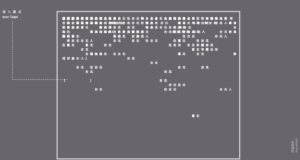This NYU Shanghai Interactive Media Arts (IMA) project was informed and shaped by an interest in translation theory and thinking about computer code in relation to language, writing, translation and siting and experiential mapping of place — in this case, Taipei. This project debuted as part of the 2020 Spring Showcase combining work by graduating seniors from NYU Shanghai IMA, NYU Interactive Technology Program/IMA, and NYU Abu Dhabi Media Arts/
Taipei, the capital of Taiwan, seems to entail a common metropolitan theme built up with the burdens of people’s ambitions and aspirations. People come for study, for work, for success and for a better future. This is the one-and-only, real stereotype that Wu found in the 60 stories she collected from non-native Taipeiers for her socially-engaged art project—台北夢 Taipei Dreams: Taipei is the ultimate place of dream-come-true. Taipei is the best.
Other “stereotypes,” Wu discovered, differ in people’s interpretation and their own experiences moving to Taipei, some of which meet their expectations, while some of them break their prejudices and form new perspectives. These are all formed during the process of trying to keep up with, imitate, and compare with each other in the fast-paced and highly-competitive environment of Taipei. Many could be subconsciously living out the “stereotypes” of what they imagined a true Taipeier should be like. This, in fact, could be why “stereotypes” are formed as people enter a new city in the process of wayfinding,
Moving to Taipei is just like creating erasure poems; entering Taipei, assimilating society’s customs and vibe, and finally redefine what it is to be a Taipeier, the experience of accommodating to a large, new city is conceptually aligned with both the technical and poetic process of erasure poetry—a text being encountered, read, and then “partially erased” in forming new interpretations of an existing narrative. By translating and erasing the collected stories, Wu used the erasure form as a personal self-reflection of her relationship with her hometown Taipei. She decided that making this into an interactive website would further enhance people’s engagement with the text, that the memories and experiences can be carried on with newly added layers of people’s own interpretations of Taipei. On the website, viewers could select texts to either reveal the original stories or make their own erasures. This is an extended spirit of the story providers and the artist, and an ever-expanding social practice and influence. These concepts are visually mapped out on the website, with juxtaposing texts crossing and overlapping each other. The diverse yet homogenized complexity of these “stereotypes” and “dreams” have to deal with the dynamic between collectivism and individualism.
A collection of city experiences, Taipei Dreams may not have the magic to achieve one’s dreams, but through interacting with city narrations, the website invites people to reflect on their own encounters. Through 台北夢, we could be closer to our dreams.

